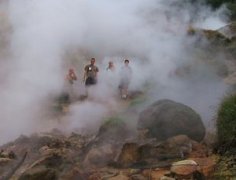There are mainly several kinds of acids in roasted coffee.

The main acids in roasted coffee are as follows-Zheng Wei (Italian Coffee University)
The following text is based on the first edition of the chemistry of quality.
The main types of acids in roasted coffee are as follows:
Formic acid is the most in shallow baking, and gradually decreases with the deepening of deep baking.
Acetic acid is the most in shallow baking, and gradually decreases with the deepening of deep baking.
Pyruvate has nothing to do with the degree of baking
Lactic acid has nothing to do with baking degree.
Malic acid is the most in shallow baking, and gradually decreases with the deepening of deep baking.
Citric acid is the most in shallow baking, and gradually decreases with the deepening of deep baking.
Quinic acid increases with the decrease of chlorogenic acid.
If you test with ARABICA% or ROBUSTA% and extract 30ml in 30 seconds, they all have a PH of 5.2.
So in terms of PH in the strict sense, coffee is "sour", but acidic and alkaline foods are not the same thing as the acid we usually drink.
The final metabolites of foods with more minerals such as potassium, sodium, calcium and magnesium are often alkaline, such as vegetables, fruits, dairy, soybeans and fungus. Properly paired with alkaline food will help to maintain acid-base balance in the body. The acidity and basicity of food has nothing to do with its own pH value (food that tastes sour is not necessarily acidic food). It is mainly defined by the fact that food is digested, absorbed and metabolized, and finally becomes acidic or alkaline in the human body. Those that produce acidic substances are called acidic foods, such as animal viscera, muscles, plant seeds (cereals). Those that produce alkaline substances are called alkaline foods, such as vegetables, melons, beans, tea and so on.
The following article comes from:
Http://www.alkaline-alkaline.com/acid_alkaline.html
NUTRITION AND ACID-ALKALINE BALANCE
Before World War II, there was considerable interest in how the food we eat affects the acid-alkaline balance of the body. While today the subject is not receiving much attention in orthodox circles, many alternative practitioners place considerable stress on the acid-base balance characteristics of various diets. In spite of a certain amount of ongoing debate, it is generally acknowledged that the food that is eaten is a major source of acid and alkali for the body (7).
Some confusion in terminology has resulted because of the way that the discussion evolved. In investigating how different foods might affect the acid-alkaline balance, various foods were burned to ash in the laboratory, and the pH of the resulting ash was measured. These foods were then classified as acid, alkaline or neutral ash foods as shown in Table 3 (8).
TABLE 3. Acid, Alkaline and Neutral Ash Foods (8)
Acid Ash FoodsAlkaline Ash FoodsNeutral Ash Foods
Bread (grains) cheesearrowroot
Cakecreambutter
Cerealmost fruitcandy
Mayonnaisejamcoffee
Cranberriesmilkcornstarch
Plumsalmondslard
Pruneschestnutsmargarine
Meatcoconutvegetable oil
Brazil nutsmolassespostum
Walnutsmost vegetableswhite sugar
Peanuts syrup
Legumes tapioca
Corn tea
Another way is to ash the food to be tested, and then test the PH value of the ash to determine whether the ingredient is acidic or alkaline.
Summary: for coffee drinkers, we should not think that coffee is alkaline because it contains caffeine (alkaloids), nor because it contains a lot of acid. It is believed that coffee is neutral after being metabolized by the human body, so drinking coffee will not destroy the acid-base balance of our body.
Important Notice :
前街咖啡 FrontStreet Coffee has moved to new addredd:
FrontStreet Coffee Address: 315,Donghua East Road,GuangZhou
Tel:020 38364473
- Prev

Salvadoran Coffee: hot Spring Water for processing Coffee Raw beans
Salvadoran coffee ranks side by side with Mexico and Guatemala as the producers of Asa and Merdo, and is fighting for the top one or two places in China and the United States with other countries. The highlands of origin are large coffee beans of all sizes, which are fragrant and mild in taste. Like Guatemala and Costa Rica, coffee in El Salvador is graded according to altitude, and the higher the altitude, the better the coffee
- Next

Description of Flavor and appearance of Coffee beans in roasting stage
Degree description stage description stage description special point description flavor and appearance description refers to baking until the end of the first burst. Light baking is rarely used and is generally used only for testing. Cinnamon roasting is widely used in some canned coffee. The firepower is difficult to reach the bean core, and it is easy to cause half-cooked condition, so
Related
- Detailed explanation of Jadeite planting Land in Panamanian Jadeite Manor introduction to the grading system of Jadeite competitive bidding, Red bid, Green bid and Rose Summer
- Story of Coffee planting in Brenka region of Costa Rica Stonehenge Manor anaerobic heavy honey treatment of flavor mouth
- What's on the barrel of Blue Mountain Coffee beans?
- Can American coffee also pull flowers? How to use hot American style to pull out a good-looking pattern?
- Can you make a cold extract with coffee beans? What is the right proportion for cold-extracted coffee formula?
- Indonesian PWN Gold Mandrine Coffee Origin Features Flavor How to Chong? Mandolin coffee is American.
- A brief introduction to the flavor characteristics of Brazilian yellow bourbon coffee beans
- What is the effect of different water quality on the flavor of cold-extracted coffee? What kind of water is best for brewing coffee?
- Why do you think of Rose Summer whenever you mention Panamanian coffee?
- Introduction to the characteristics of authentic blue mountain coffee bean producing areas? What is the CIB Coffee Authority in Jamaica?

